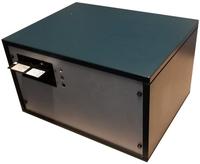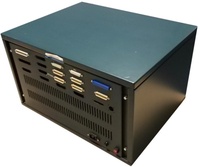British Antarctic Survey "Micro"
| Home > Browse Our Collection > Computers > Custom-Built Computers > British Antarctic Survey "Micro" |
|
We are grateful to Michael Pinnock of the British Antarctic Survey for the following description of this exhibit: A custom-made microcomputer used by the British Antarctic Survey (BAS) on its Antarctic research stations, ships, aircraft, and its Cambridge research institute. It was primarily designed for controlling and logging data from experiments (e.g. automatic weather stations, airborne geophysics, shipborne oceanography) but could also be used for data and text processing. Its design evolved in the early 1980s (1980-1982) and some 25 of them were produced by 1985. The last unit was taken out of service in 2003 - at that time it was still reliably logging geomagnetic field data at BAS's Halley research station. Based around a Motorola 6809 processor, it ran the Flex operating system. The design owes much to the rapidly evolving Cambridge microcomputer scene in the early 1980s, e.g. the first processor board used was an Acorn Atom design, although later units had a custom made processor board. Additional design details from Jim Turton: The BAS micro was indeed spawned from the SWTPC and Flex. However the hardware was more similar to the CMS (Cambridge Microprocessor Systems) board, which was a single board 6809 computer that also ran Flex DOS. This was also inspired by the Acorn Atom single boards around at the time. Acorn mostly used the 6502 processor - later used in the BBC Micro, but it did make a 6809 version. Although Acorn never used Flex like CMS. Essentially we cribbed this idea to design our own 19 inch card frame board. We designed the hardware and it was laid out on PCB by one Arthur Bartrum of 'Batvale' in Sutton. The processor board had 6809 processor and 8k of static memory plus address decoding only. We also developed our own bootstrap monitor which had some powerful debugging features. Additional cards had an ACIA (6851) serial port (for RS232) terminal comms, a PIA (6820) for a parallel printer port and a PIA for disc interface. Other cards had various custom interfaces such as ADC's and DAC's for experiment interfacing. For the printer we used the Epson RX80 dot matrix printer then the FX80 (or the other way round). The system supported two 5.25 inch floppy drives. One for the Flex DOS and programs and the other for data. Manufacturer: British Antarctic Survey Comment on This Page Other Systems Related To British Antarctic Survey "Micro":
This exhibit has a reference ID of CH39714. Please quote this reference ID in any communication with the Centre for Computing History. |
|












